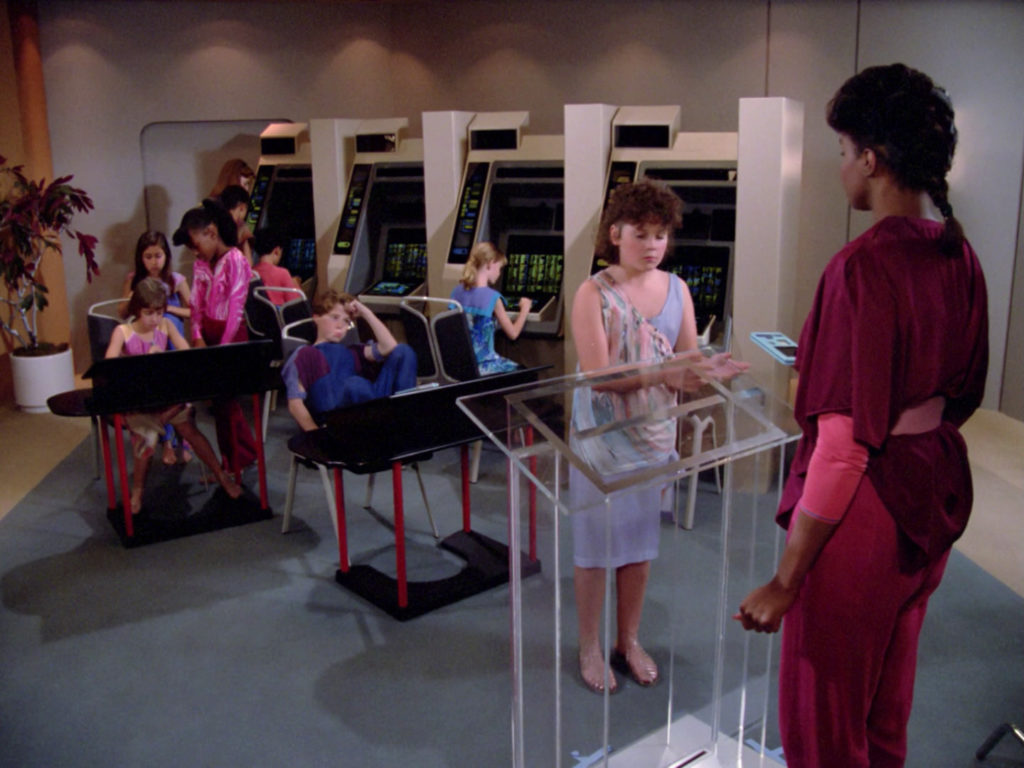
Watching Star Trek I often thought about how I would fit in if I was suddenly dropped into the Star Trek Universe. Who would I be friends with? (Dax, Tilly, Spock) What would my job be on board? Lately I’ve been thinking a lot about the second question. I’ve come to the conclusion that despite all the varied fields in the Star Trek future, if I suddenly found myself in that universe I’d still want to be a teacher.
This led to me thinking “what would my job look like on a starship?” TNG seemed like the best place to start because the Enterprise-D is the first time we see a space for children made on board the flagship.
I decided to look into the education of children onboard the Enterprise and see how it compares to my own experiences as a public school teacher. In watching episodes of TNG as a teacher, three big ideas stood out to me: classroom space, instructional methods, and mental health in schools.
Classroom Space
Walking into any classroom physical space is something that stands out right away and often forms the first impression parents and students have of a space. Pinterest, Instagram, and blogs are full of teachers sharing tips and tricks for how to design your own classroom and teachers put a lot of time and effort into setting up and designing their classroom spaces.
“Hero Worship”, “New Ground”, “Rascals” and “When the Bough Breaks” all give viewers a peek into the classrooms on the Enterprise-D The first thing that stood out to me in both “New Ground” and “Rascals” was how sparse the decorations in the rooms appeared to be. On the walls we see some letters mixed up with other symbols (maybe another language spoken in the Federation?) and a few shelves with plants and other items on them.
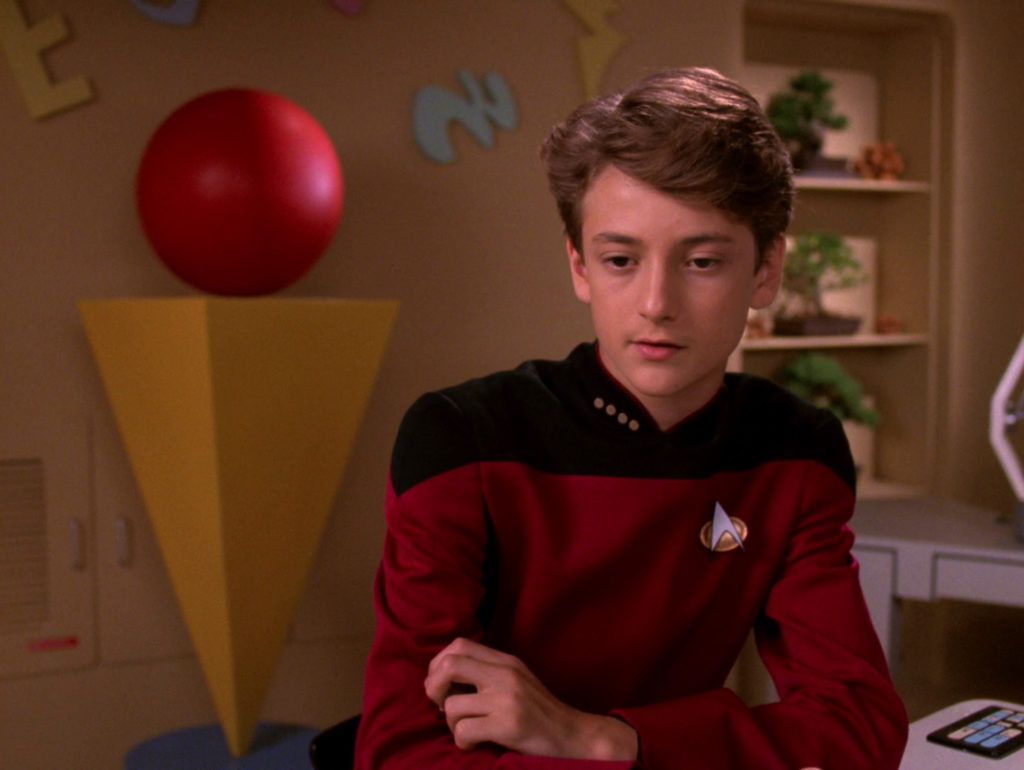
From “Rascals.” If you look behind Picard you can see the symbols on the walls of the classroom.
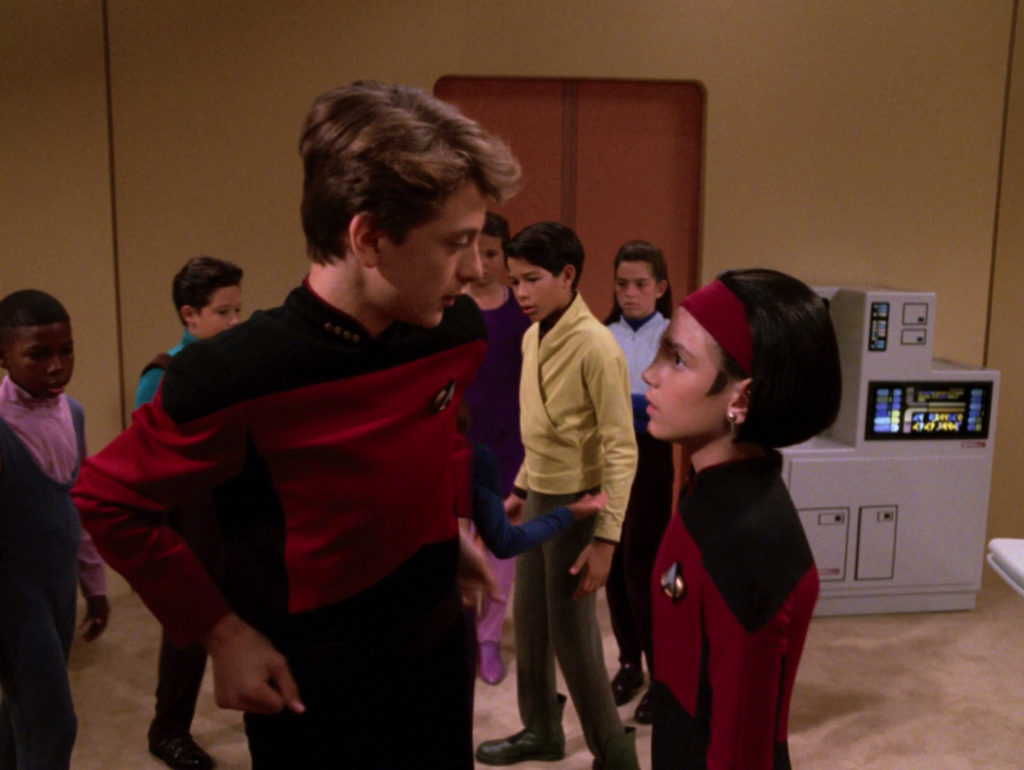
Classroom from “Rascals” showing how sparse the decorations on the walls are.
The classroom spaces in “Hero Worship” seem to have a little more happening in them. We see one room with different work stations and another with a play structure of some sort in the center. In “When the Bough Breaks” we also see a classroom with rows of desks at the center and computer stations off to the side. It is clear that technology is an important part of each of these classrooms. In “Rascals” we learn that the children can talk to the computer much like the adults can. My general impression was that the classrooms on the Enterprise lacked the sort of personality you see in many modern classrooms, especially those for the younger grades.
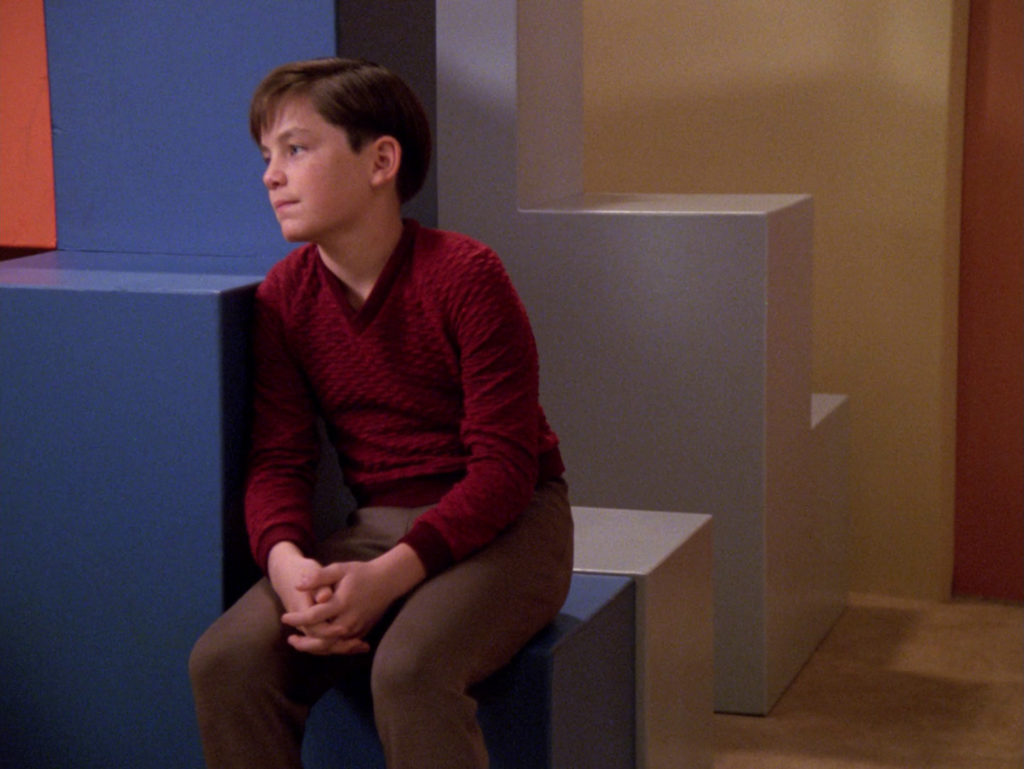
Classroom from “Hero Worship”. Here we are able to see part of the play structure in this classroom.
These classroom environments contrast greatly with my own kindergarten classroom. The walls in my room have a word wall, a calendar, anchor charts about topics we have covered, and student art work. While I try not to make my classroom too busy as this can have a negative impact on students, the right amount of meaningfully-placed decoration can benefit students. Showing students’ work gives them ownership over the classroom space and they also are more likely to remember the material. References like word walls and hundreds charts also allow students to be more independent while doing their work.
While I have some technology in my classroom (a smart board and a teacher computer) there is nowhere near as much as there is aboard the Enterprise-D. I do think that this is an area where my classroom could be more like those on the Enterprise. Having more technology in my own classroom could help my students become more technologically literate.
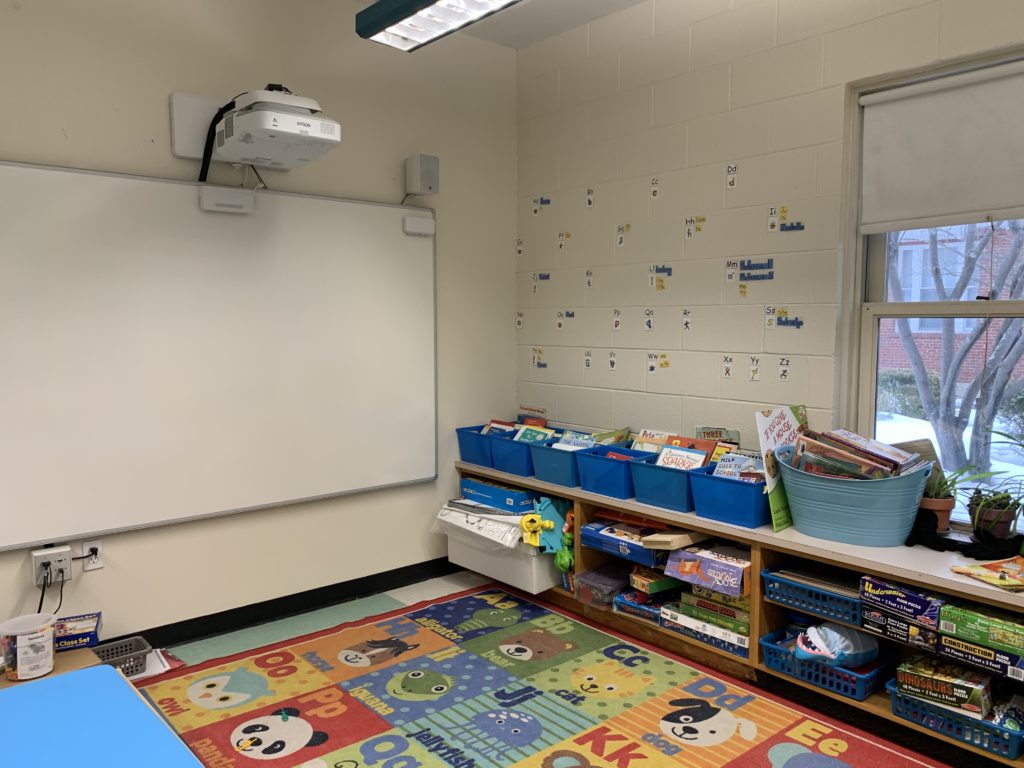
A photo from my classroom showing our word wall.
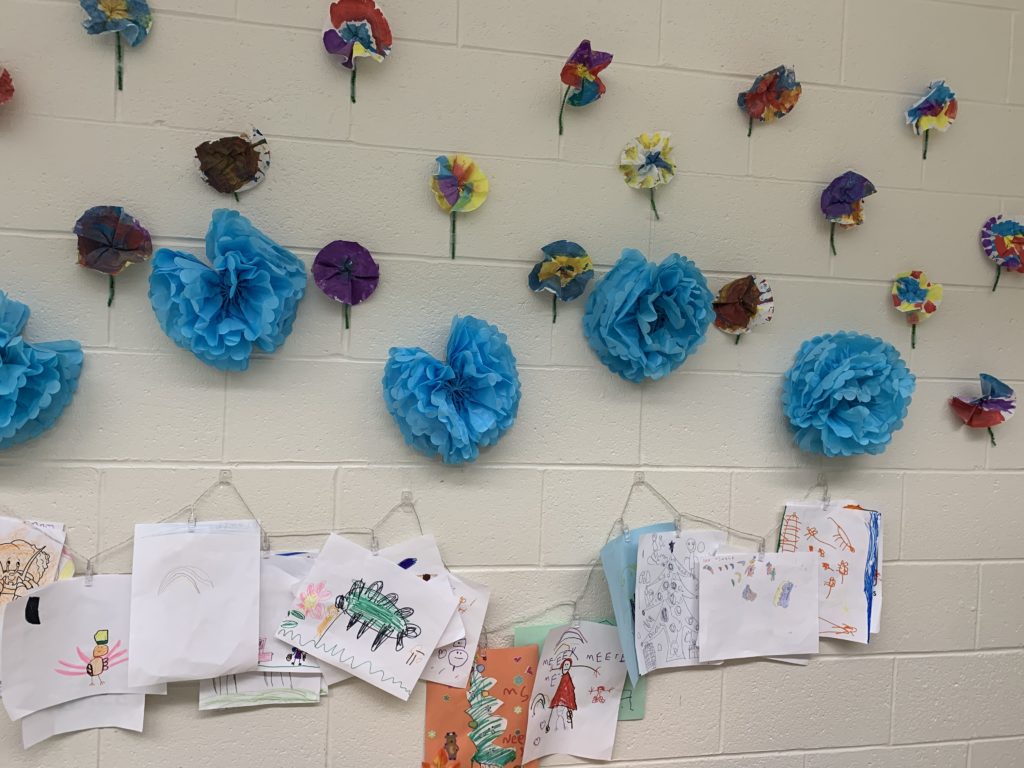
Another wall of my classroom displaying student art.
Instructional Methods
Thinking about instructional methods was a little trickier than classroom space as we get to see less actual teaching happen in TNG. However, I was still able to draw some conclusions about the teachers’ methods. In “Hero Worship” we learn that sculpture and mythology are two topics covered in Federation schools and in “When the Bough Breaks,” we hear a child talk about calculus class. Based on these moments it appears as if students in Federation schools are exposed to a wide range of lesson topics.
One method of teaching I noticed in “Hero Worship” is independent small group work. We see a group of three students working at a small table and another group of students working at desks on computers. In “New Ground” we also see that field trips to different parts of the ship are part of the school day. Alexander’s class learns about endangered species by going to see an exhibit. I would infer that hands-on learning experiences are valued by teachers on the Enterprise.
I was able to see some similarities between my own instructional methods and those of the teachers on the Enterprise. In structuring my own classroom schedule I also like to make time for small group work during the day. I include it in both my literacy and math blocks. The work the students were doing in “Hero Worship” was reminiscent of the work around measurement my own students have been engaged in. In Math, my students have been learning about weight by exploring with balances. They work with a partner to determine how many pennies an object weighs. I gave them the information needed to complete the task and then took a step back to see what they were able to accomplish on their own.
I also appreciated how the Enterprise school day makes time for the arts (sculpture). Today many schools faced with budget crisis cut funding for the arts, and I was glad to see that in the Star Trek version of the future arts are an integral part of children’s education. I think one of the most exciting aspects of teaching on board a starship would be the myriad of field trip opportunities. Even if kids aren’t allowed to leave the ship for trips, there are endless opportunities on board from visiting Engineering to a trip to the arboretum. I’m sure I could think of a field trip for any topic I wanted to cover with my students.
Mental Health in School
It was not until I started watching these episodes that I considered how big of a role Counselor Troi would play in schools on the Enterprise-D. In “Hero Worship”, “New Ground”, and “Imaginary Friend”, we get to see Counselor Troi do some of her best work supporting children who have experienced trauma or who are simply struggling. We see her observing students in the classroom, consulting with their parents, and having a variety of sessions with the kids themselves. While we don’t ever see her speaking with teachers I imagine she would be consulting with them.
As a teacher in a school where students have experienced lots of trauma I can’t stress enough how important a school counselor is. The counselor at my school is amazing and I don’t know what the students (or teachers for that matter) would do without her. In 2018 in the United States 47% of students have experienced at least one event that could be considered trauma. I’m sure this number would be even higher on board a spaceship, especially the Federation’s flagship.
Final Thoughts
Despite being set 500 years in the future, there are many similarities between my teaching and the teaching on the Enterprise-D. If I were suddenly on Picard’s Enterprise I do see a place for myself and I know I would happily celebrate Captain Picard Day.
I’m not a teacher, so getting to learn more about someone else job and point of view is always made easier by using the lens of Trek.
Thank you!
Thanks so much!
I am also a teacher and I appreciate this essay very much
Thank you so much! I always love to hear from other teachers.